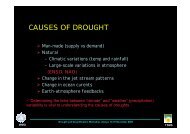training course on weather radar systems - RTC, Regional Training ...
training course on weather radar systems - RTC, Regional Training ...
training course on weather radar systems - RTC, Regional Training ...
- No tags were found...
Create successful ePaper yourself
Turn your PDF publications into a flip-book with our unique Google optimized e-Paper software.
MODULE A- INTRODUCTION TO RADAR<br />
(Doppler filter bank to cover the Doppler spectrum) are used rather than a simple MTI<br />
system described above, in order to cancel clutter and to extract the Doppler frequency<br />
and amplitude comp<strong>on</strong>ents of the received signal.<br />
By extracting the Doppler characteristics of signals it is possible to achieve much better clutter<br />
cancellati<strong>on</strong> than in c<strong>on</strong>venti<strong>on</strong>al <strong>radar</strong>s, and the target’s radial velocity comp<strong>on</strong>ent can be<br />
calculated <strong>on</strong>ce the Doppler frequency is measured, in additi<strong>on</strong> it is possible by range gating to<br />
measure the Doppler and the amplitude of the returned signal in each <strong>radar</strong> cell. The locati<strong>on</strong> of<br />
the <strong>radar</strong> cell by measuring the return time, the positi<strong>on</strong> of the antenna (azimuth and elevati<strong>on</strong>) at<br />
the time the signal in the <strong>radar</strong> cell was received. All this processing is d<strong>on</strong>e digitally. A simple<br />
block shows the essential comp<strong>on</strong>ents of the Pulse Doppler Radar that is used for <strong>weather</strong><br />
observati<strong>on</strong>.<br />
4.11. Weather Radars<br />
Although these names refer to the applicati<strong>on</strong> of <strong>radar</strong>, there is a significant difference in the type<br />
of <strong>radar</strong> that is used which is worth to be illustrated. In general <strong>radar</strong>s measure the locati<strong>on</strong> of a<br />
target that is range, azimuth and height. The major distincti<strong>on</strong> between meteorological <strong>radar</strong> and<br />
other kinds of <strong>radar</strong>s lies in the nature of the targets. Meteorological targets are distributed in<br />
space and occupy a large fracti<strong>on</strong> of the spatial resoluti<strong>on</strong> cells observed by the <strong>radar</strong>. Weather<br />
<strong>radar</strong>s are pulsed <strong>radar</strong>s with Doppler capability. So we can call them as Pulsed Doppler Weather<br />
Radars. Weather <strong>radar</strong>s can operate in different frequency bands. So a classificati<strong>on</strong> can be made<br />
based <strong>on</strong> the frequency band as follows:<br />
L band <strong>radar</strong>s<br />
Those <strong>radar</strong>s operate <strong>on</strong> a wavelength of 15-30 cm and a frequency of 1-2 GHz. L band <strong>radar</strong>s<br />
are mostly used for clear air turbulence studies.<br />
S band <strong>radar</strong>s<br />
Those <strong>radar</strong>s operate <strong>on</strong> a wavelength of 8-15 cm and a frequency of 2-4 GHz. Because of the<br />
wavelength and frequency, S band <strong>radar</strong>s are not easily attenuated. This makes them useful for<br />
near and far range <strong>weather</strong> observati<strong>on</strong>. It requires a large antenna dish and a large motor to<br />
power it. It is not uncomm<strong>on</strong> for an S band dish to exceed 25 feet in size.<br />
TURKEY RADAR TRAINING 1.0 / ALANYA 2005 39
















